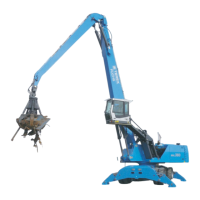2 SAFETY AND ACCIDENT PREVENTION
2.20 MHL380 D
2.3.9 Hydraulic hoses and hose lines
It is forbidden to repair hydraulic hoses and
hydraulic hose lines!
All hoses, hose lines, and screw couplings
must be regularly inspected every 2 weeks
(or immediately if damage is suspected) for
leaks and externally visible damage!
Replace any damaged parts immediately!
Spraying oil can cause injuries and/or fires.
Even if they are stored properly and
subjected only to permissible loads, hoses
and hose lines are susceptible to natural
wear. Their service life is therefore limited.
- Improper storage, mechanical damage
and impermissible use are the most
frequent causes of failure.
- With regard to service life, all standards,
rules, and regulations regarding hoses
and hose lines which are applicable at the
site of operation must be observed.
- Use in the limit zone of permissible load
can reduce service life (for example high
temperatures, frequent changing
movements, extremely high pulse
frequencies, multi-shift operation).
Hoses and hose lines must be replaced if
any of the following conditions are
encountered during inspections:
- damage to the outer hose up to the insert
(e.g. abrasion, cuts and tears)
- thinning of the outer layer (appearance of
cracks in the hose material)
- deformation distorting the natural shape of
the hose or hose line both when
pressurized and when depressurized, as
well as when bent (e.g. separation of
layers, formation of bubbles)
- leaks
- noncompliance with installation
requirements
- damage to or deformation of the hose
fitting that reduces the stability of the
fitting or the hose/fitting connection
- hose coming loose from the fitting
- corrosion of the fitting which reduces
functionality and stability
- exceeding of storage times and usage
periods
When replacing hoses and hose lines, use
only original spare parts.
Lay and mount hoses and hose lines
properly. Do not mix up connections.
When replacing hoses and hose lines,
please note:
- Always make certain hoses and hose
lines are not under torsion when installed.
For high-pressure hose lines, the screws
and half-clamps or full flanges at both
ends of the hose must be fitted first and
then tightened.
- For high-pressure hoses and hose lines
with curved fittings, when tightening the
flange, the side with the curved fitting
must always be tightened first, followed by
the side with the straight fitting.
- Any fastening clamps located in the
middle of the hose must be attached first
and then tightened.
- Check daily to make certain all clamps,
covers, and protective devices are
properly fastened. This will prevent
vibrations and damage during operation.
- Lay the hoses and hose lines so that they
cannot rub against other hoses or parts.

